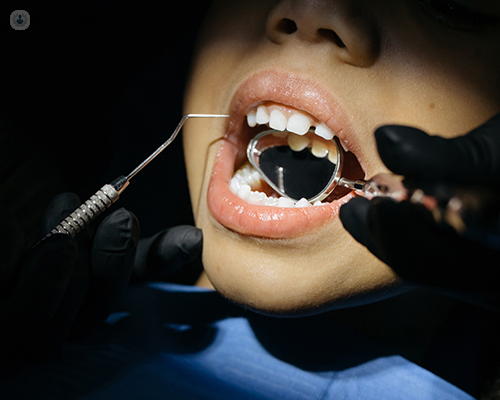What is the exposure and bonding of a tooth?
Escrito por:In this article, Ms Lisa Greaney, renowned Consultant Oral and Maxillofacial Surgeon, provides an expert insight into the exposure and bonding of a tooth in paediatric patients.
The London-based specialist discusses what the procedure involves, why it is performed, and if there are any alternative treatments, among other important points.

What is the exposure and bonding of a tooth?
Exposure and bonding is a dental procedure in which an impacted tooth is uncovered and bonded to an orthodontic attachment to allow an orthodontist to guide the tooth into a functional position.
During the procedure, the surgeon lifts back the gum tissue over the unerupted tooth to expose the tooth underneath. A bracket, which is connected to a gold chain, is then stuck onto the surface of the impacted tooth. After the gum tissue over the impacted tooth has been replaced in its correct position, the orthodontist can then use the chain attached to the bracket to gently pull and move the tooth into the desired place.
The exposure and bonding process involves the multidisciplinary work of the oral and maxillofacial surgeon and orthodontist. The procedure usually takes around or under an hour if one / two teeth are being exposed and bonded. If only a simple, open exposure is required, surgery can take as little as 30 minutes.
Why might my child need this procedure?
Exposure and bonding is one of the most common procedures for the treatment of impacted teeth. These tend to be teeth that have not emerged from the gums or that have done so only partially, usually due to lack of space in the mouth or because the tooth is emerging at a wrong angle. Impacted teeth can cause pain and infection, prevent the other teeth from being straightened, and most importantly cause damage to the other teeth in the mouth.
Exposure and bonding is a safe and effective procedure that can prevent the development of more serious dental problems in the future.
Is exposure and bonding of a tooth painful?
Exposure and bonding is performed under both local anaesthesia (which means that patients will not feel any pain during the process) and general anaesthesia, depending on the complexity of the surgery. This is a discussion that is held between the patient and clinician in order to consider the best anaesthesia for that particular episode.
After the dental procedure, patients may feel some discomfort or sensitivity in the affected area, but this can usually be managed with simple over-the-counter painkillers like ibuprofen.
What is the usual recovery time after exposure and bonding of a tooth?
Recovery is usually very quick, with most patients being able to return to their daily activities within a day or two. It is important to follow the post-operative instructions carefully to ensure proper healing of the gum tissue.
What are the alternatives to exposure and bonding of a tooth?
There are several alternatives to exposure and bonding, depending on the severity of the impaction and the patient’s age.
These include:
- Extraction: In some cases, it may be necessary to remove the impacted tooth completely.
- No treatment: If the disadvantages of a procedure outweigh the risks of leaving the impacted tooth in situ, then this option might be appropriate. These can include reasons such as the general medical health of the patient.
A surgeon can help parents to determine which treatment is the most suitable for their child.
Ms Lisa Greaney is a highly skilled consultant oral and maxillofacial surgeon with over 20 years’ experience.
If your child requires exposure and bonding for an impacted tooth/teeth and you would like to consult your options with an expert, don’t hesitate to book an appointment with Ms Greaney via her Top Doctors profile today.


